Transcriptome Analysis of Chinese Cabbage Provides Insights into the Basis of Understanding the Lignin Affected by Low Temperature
Abstract
1. Introduction
2. Materials and Methods
2.1. Plant Materials and Treatments
2.2. Determination of Lignin Content
2.3. RNA Extraction and Illumina Sequencing
2.4. RNA-Seq Analysis
2.5. Gene Co-Expression Network Analysis and Visualization
2.6. Histochemistry and Autofluorescence Microscopy
2.7. COMT Gene Sequence Alignment, Phylogenetic Analyses, and Gene Structure Determination
2.8. qRT-PCR Analysis and Statistical Analysis
3. Results
3.1. Identification and Characterization of RNA in Chinese Cabbage at Low-Temperature Stage
3.2. Gene Co-Expression Network Construction of Low-Temperature Environment Found That It Is Related to the Lignin Biosynthetic Process
3.3. Lignin Biosynthetic Process Analysis and Related Genes Identification
3.4. COMT Gene Sequence and Conserved Analysis
3.5. qRT-PCR Validation of COMT Genes
4. Discussion
5. Conclusions
Supplementary Materials
Author Contributions
Funding
Institutional Review Board Statement
Informed Consent Statement
Data Availability Statement
Conflicts of Interest
References
- Dai, Y.; Zhang, L.; Sun, X.; Li, F.; Zhang, S.F.; Zhang, H.; Li, G.L.; Fang, Z.Y.; Sun, R.F.; Hou, X.L.; et al. Transcriptome analysis reveals anthocyanin regulation in Chinese cabbage (Brassica rapa L.) at low temperatures. Sci. Rep. 2022, 12, 6308. [Google Scholar] [CrossRef] [PubMed]
- Taylor, A.O.; Craig, A.S. Plants under Climatic Stress: II. Low Temperature, High Light Effects on Chloroplast Ultrastructure. Plant Physiol. 1971, 47, 719–725. [Google Scholar] [CrossRef] [PubMed]
- Huner, N.P.A.; Öquist, G.; Hurry, V.M.; Krol, M.; Griffith, M. Photosynthesis, photoinhibition and low temperature acclimation in cold tolerant plants. Photosynth Res. 1993, 37, 19–39. [Google Scholar] [CrossRef] [PubMed]
- Fan, H.; Du, C.; Xu, Y.; Wu, X. Exogenous nitric oxide improves chilling tolerance of Chinese cabbage seedlings by affecting antioxidant enzymes in leaves. Hortic. Environ. Biotechnol. 2014, 55, 159–165. [Google Scholar] [CrossRef]
- Liu, A.; Hu, Z.; Bi, A.; Fan, J.; Gitau, M.M.; Amombo, E.; Chen, L.; Fu, J. Photosynthesis, antioxidant system and gene expression of bermudagrass in response to low temperature and salt stress. Ecotoxicology 2016, 25, 1445–1457. [Google Scholar] [CrossRef] [PubMed]
- Pinedo, M.L.; Hernández, G.F.; Conde, R.D.; Tognetti, J.A. Effect of Low Temperature on the Protein Metabolism of Wheat Leaves. Bio. Plantarum 2000, 43, 363–367. [Google Scholar] [CrossRef]
- Li, Q.; Yang, L.; Duan, Q.; Huang, J. Effects of exogenous melatonin on the growth and physiological characteristics of Chinese cabbage seedlings under chilling stress. J. Shandong Agric. Univ. 2021, 52, 182–186. [Google Scholar]
- Wang, Z.; Wang, F.; Tang, J.; Huang, Z.; Xiong, A.; Hou, X. C-repeat binding factor gene family identified in non-heading Chinese cabbage is functional in abiotic and biotic stress response but different from that in Arabidopsis. Acta Physiol. Plant 2014, 36, 3217–3229. [Google Scholar] [CrossRef]
- Wang, Z.; Tangg, J.; Hu, R.; Wu, P.; Hou, X.; Songv, X.; Xiong, A. Genome-wide analysis of the R2R3-MYB transcription factor genes in Chinese cabbage (Brassica rapa ssp. pekinensis) reveals their stress and hormone responsive patterns. BMC Genom. 2015, 16, 17. [Google Scholar] [CrossRef]
- Moura-Sobczak, J.; Souza, U.; Mazzafera, P. Drought stress and changes in the lignin content and composition in Eucalyptus. BMC Proc. 2011, 5, P103. [Google Scholar] [CrossRef]
- Hu, Y.; Li, W.C.; Xu, Y.Q.; Li, G.J.; Liao, Y.; Fu, F.L. Differential expression of candidate genes for lignin biosynthesis under drought stress in maize leaves. J. Appl. Genet. 2009, 50, 213–223. [Google Scholar] [CrossRef] [PubMed]
- Zhang, S.H.; Yang, Q.; Ma, R.C. Erwinia carotovora ssp. Carotovora infection induced “defense lignin” accumulation and lignin biosynthetic gene expression in chinese cabbage (Brassica rapa L. ssp pekinensis). J. Integr. Plant Biol. 2007, 49, 993–1002. [Google Scholar] [CrossRef]
- Karkonen, A.; Koutaniemi, S. Lignin Biosynthesis Studies in Plant Tissue Cultures. J. Integr. Plant Biol. 2010, 52, 176–185. [Google Scholar] [CrossRef] [PubMed]
- Duan, C.X.; Yu, J.J.; Bai, J.Y.; Zhu, Z.D.; Wang, X.M. Induced defense responses in rice plants against small brown planthopper infestation. Crop J. 2014, 2, 55–62. [Google Scholar] [CrossRef]
- Jannoey, P.; Channei, D.; Kotcharerk, J.; Pongprasert, W.; Nomura, M. Expression Analysis of Genes Related to Rice Resistance Against Brown Planthopper, Nilaparvata lugens. Rice Sci. 2017, 24, 163–172. [Google Scholar] [CrossRef]
- Yang, Q.; He, Y.J.; Kabahuma, M.; Chaya, T.; Kelly, A.; Borrego, E.; Bian, Y.; El Kasmi, F.; Yang, L.; Teixeira, P.; et al. A gene encoding maize caffeoyl-CoA O-methyltransferase confers quantitative resistance to multiple pathogens. Nat. Genet. 2017, 49, 1364–1375. [Google Scholar] [CrossRef]
- Gindl, W.; Grabner, M.; Wimmer, R. The influence of temperature on latewood lignin content in treeline Norway spruce compared with maximum density and ring width. Trees-Struct. Funct. 2000, 14, 409–414. [Google Scholar] [CrossRef]
- Hausman, J.F.; Evers, D.; Thiellement, H.; Jouve, L. Compared responses of poplar cuttings and in vitro raised shoots to short-term chilling treatments. Plant Cell Rep. 2000, 19, 954–960. [Google Scholar] [CrossRef]
- Zhao, S.; Pham Anh, T.; Li, X.; Kim, Y.; Kim, H.; Park, C.; Yang, J.; Li, C.; Park, S. Identification of phenylpropanoid biosynthetic genes and phenylpropanoid accumulation by transcriptome analysis of Lycium chinense. BMC Genom. 2013, 14, 802. [Google Scholar] [CrossRef]
- Bi, H.T.; Guo, M.L.; Wang, J.W.; Qu, Y.; Du, W.L.; Zhang, K.M. Transcriptome analysis reveals anthocyanin acts as a protectant in Begonia semperflorens under low temperature. Acta Physiol. Plant. 2018, 40, 10. [Google Scholar] [CrossRef]
- Zhang, W.Q.; Zhang, S.K.; Lu, X.Q.; Li, C.; Liu, X.W.; Dong, G.Y.; Xia, T. Tissue-specific Transcriptome analysis reveals lignocellulose synthesis regulation in elephant grass (Pennisetum purpureum Schum). BMC Plant Biol. 2020, 20, 1–12. [Google Scholar] [CrossRef] [PubMed]
- Trapnell, C.; Roberts, A.; Goff, L.; Pertea, G.; Kim, D.; Kelley, D.R.; Pimentel, H.; Salzberg, S.L.; Rinn, J.L.; Pachter, L. Differential gene and transcript expression analysis of RNA-seq experiments with TopHat and Cufflinks. Nat. Protoc. 2012, 7, 562–578. [Google Scholar] [CrossRef] [PubMed]
- Love, M.I.; Huber, W.; Anders, S. Moderated estimation of fold change and dispersion for RNA-seq data with DESeq2. Genome Biol. 2014, 15, 550. [Google Scholar] [CrossRef] [PubMed]
- Benjamini, Y.; Hochberg, Y. Controlling the false discovery rate—A practical and powerful approach to multiple testing. J. R. Stat. B. 1995, 57, 289–300. [Google Scholar] [CrossRef]
- Young, M.D.; Wakefield, M.J.; Smyth, G.K.; Oshlack, A. Gene ontology analysis for RNA-seq: Accounting for selection bias. Genome Biol. 2010, 11, R14. [Google Scholar] [CrossRef] [PubMed]
- Mao, X.Z.; Cai, T.; Olyarchuk, J.G.; Wei, L.P. Automated genome annotation and pathway identification using the KEGG Orthology (KO) as a controlled vocabulary. Bioinformatics 2005, 21, 3787–3793. [Google Scholar] [CrossRef]
- Langfelder, P.; Horvath, S. WGCNA: An R package for weighted correlation network analysis. BMC Bioinform. 2008, 9, 559. [Google Scholar] [CrossRef]
- Kumar, S.; Stecher, G.; Tamura, K. MEGA7: Molecular Evolutionary Genetics Analysis Version 7.0 for Bigger Datasets. Mol. Biol. Evol. 2016, 33, 1870–1874. [Google Scholar] [CrossRef]
- Chen, C.J.; Chen, H.; Zhang, Y.; Thomas, H.R.; Frank, M.H.; He, Y.H.; Xia, R. TBtools: An Integrative Toolkit Developed for Interactive Analyses of Big Biological Data. Mol. Plant 2020, 13, 1194–1202. [Google Scholar] [CrossRef]
- Lescot, M.; Dehais, P.; Thijs, G.; Marchal, K.; Moreau, Y.; Van de Peer, Y.; Rouze, P.; Rombauts, S. PlantCARE, a database of plant cis-acting regulatory elements and a portal to tools for in silico analysis of promoter sequences. Nucleic Acids Res. 2002, 30, 325–327. [Google Scholar] [CrossRef]
- Livak, K.J.; Schmittgen, T.D. Analysis of relative gene expression data using real-time quantitative PCR and the 2(T)(-Delta Delta C) method. Methods 2001, 25, 402–408. [Google Scholar] [CrossRef] [PubMed]
- Zhang, L.; Cai, X.; Wu, J.; Liu, M.; Grob, S.; Cheng, F.; Liang, J.L.; Cai, C.C.; Liu, Z.Y.; Liu, B.; et al. Improved Brassica rapa reference genome by single-molecule sequencing and chromosome conformation capture technologies. Hortic. Res. 2018, 5, 50. [Google Scholar] [CrossRef] [PubMed]
- Liu, Q.Q.; Luo, L.; Zheng, L.Q. Lignins: Biosynthesis and Biological Functions in Plants. Int. J. Mol. Sci. 2018, 19, 335. [Google Scholar] [CrossRef] [PubMed]
- Lee, C.J.; Kim, S.E.; Park, S.U.; Lim, Y.H.; Choi, H.Y.; Kim, W.G.; Ji, C.Y.; Kim, H.S.; Kwak, S.S. Tuberous roots of transgenic sweetpotato overexpressing IbCAD1 have enhanced low-temperature storage phenotypes. Plant Physiol. Bioch. 2021, 166, 549–557. [Google Scholar] [CrossRef]
- Le Gall, H.; Philippe, F.; Domon, J.-M.; Gillet, F.; Pelloux, J.; Rayon, C. Cell Wall Metabolism in Response to Abiotic Stress. Plants 2015, 4, 112–166. [Google Scholar] [CrossRef]
- Ji, H.; Wang, Y.; Cloix, C.; Li, K.; Jenkins, G.I.; Wang, S.; Shang, Z.; Shi, Y.; Yang, S.; Li, X. The Arabidopsis RCC1 family protein TCF1 regulates freezing tolerance and cold acclimation through modulating lignin biosynthesis. PLoS Genet. 2015, 11, 1005471. [Google Scholar] [CrossRef] [PubMed]
- Kreuzwieser, J.; Hauberg, J.; Howell, K.A.; Carroll, A.; Rennenberg, H.; Millar, A.H.; Whelan, J. Differential Response of Gray Poplar Leaves and Roots Underpins Stress Adaptation during Hypoxia. Plant Physiol. 2009, 149, 461–473. [Google Scholar] [CrossRef] [PubMed]
- Wang, Y.H.; Wu, X.J.; Sun, S.; Xing, G.M.; Wang, G.L.; Que, F.; Khadr, A.; Feng, K.; Li, T.; Xu, Z.S.; et al. DcC4H and DcPER Are Important in Dynamic Changes of Lignin Content in Carrot Roots under Elevated Carbon Dioxide Stress. J. Agr. Food Chem. 2018, 66, 8209–8220. [Google Scholar] [CrossRef]
- Liu, W.L.; Zhang, J.; Jiao, C.; Yin, X.R.; Fei, Z.J.; Wu, Q.B.; Chen, K.S. Transcriptome analysis provides insights into the regulation of metabolic processes during postharvest cold storage of loquat (Eriobotrya japonica) fruit. Horticulture Res. 2019, 6, 49. [Google Scholar] [CrossRef]
- dos Santos, A.B.; Bottcher, A.; Vicentini, R.; Mayer, J.L.S.; Kiyota, E.; Landell, M.A.G.; Creste, S.; Mazzafera, P. Lignin biosynthesis in sugarcane is affected by low temperature. Environ. Exp. Bot. 2015, 120, 31–42. [Google Scholar] [CrossRef]
- Kim, J.; Choi, B.; Cho, B.K.; Lim, H.S.; Kim, J.B.; Natarajan, S.; Kwak, E.; Bae, H. Molecular cloning, characterization and expression of the caffeic acid O-methyltransferase (COMT) ortholog from kenaf (Hibiscus cannabinus). Plant Omics 2013, 6, 246–253. [Google Scholar]
- Li, W.; Lu, J.X.; Lu, K.; Yuan, J.L.; Huang, J.H.; Du, H.; Li, J.N. Cloning and Phylogenetic Analysis of Brassica napus L. Caffeic Acid O-Methyltransferase 1 Gene Family and Its Expression Pattern under Drought Stress. PLoS ONE 2016, 11, e0165975. [Google Scholar] [CrossRef] [PubMed]
- Li, J.J.; Zhang, G.; Yu, J.H.; Li, Y.Y.; Huang, X.H.; Wang, W.J.; Tan, R.; Zhou, J.Y.; Liao, H. Molecular cloning and characterization of caffeic acid 3-O-methyltransferase from the rhizome of Ligusticum chuanxiong. Biotechnol. Lett. 2015, 37, 2295–2302. [Google Scholar] [CrossRef] [PubMed]
- Song, S.; Zhou, H.Y.; Sheng, S.B.; Cao, M.; Li, Y.Y.; Pang, X.M. Genome-Wide Organization and Expression Profiling of the SBP-Box Gene Family in Chinese Jujube (Ziziphus jujuba Mill.). Int. J. Mol. Sci. 2017, 18, 1734. [Google Scholar] [CrossRef]
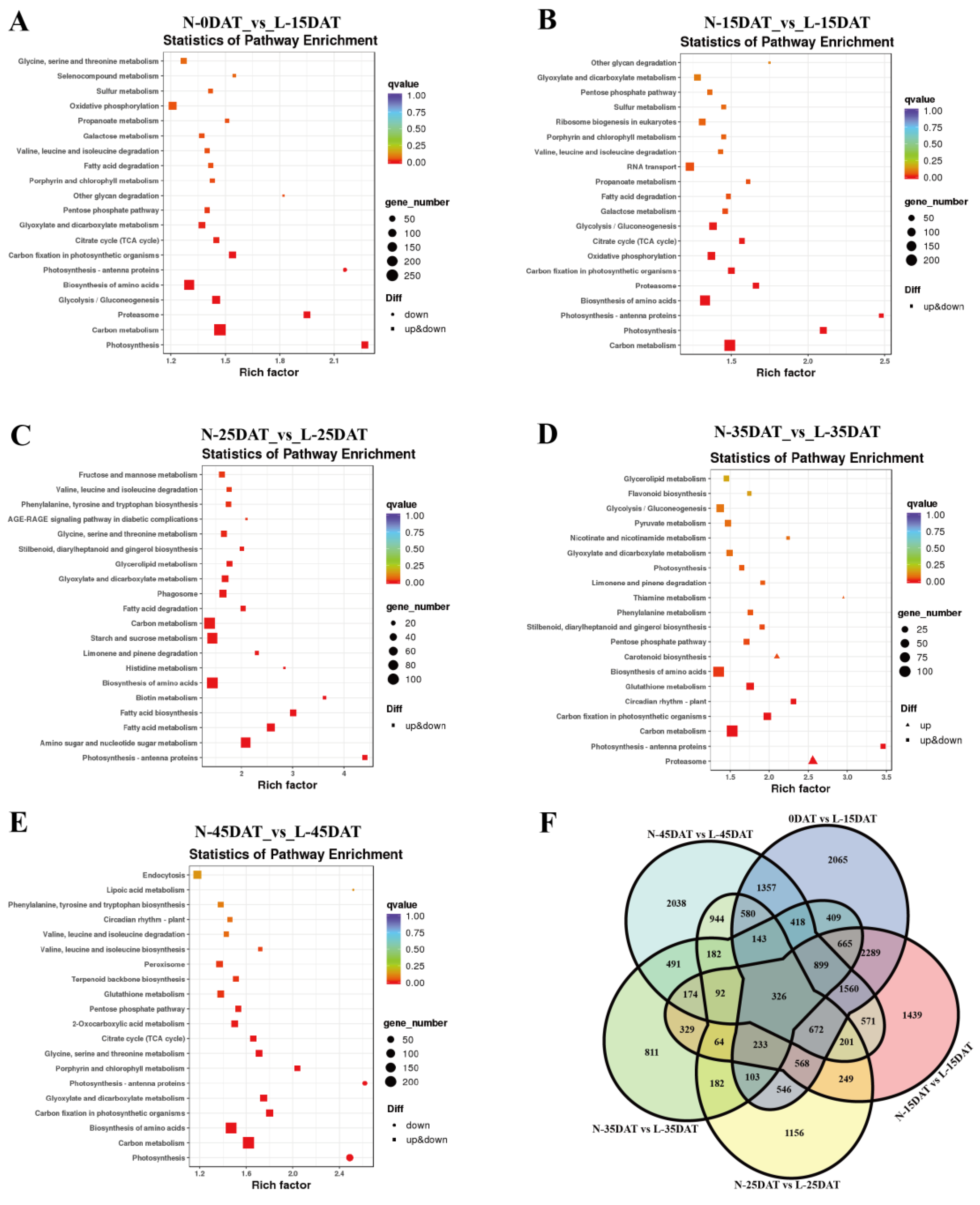


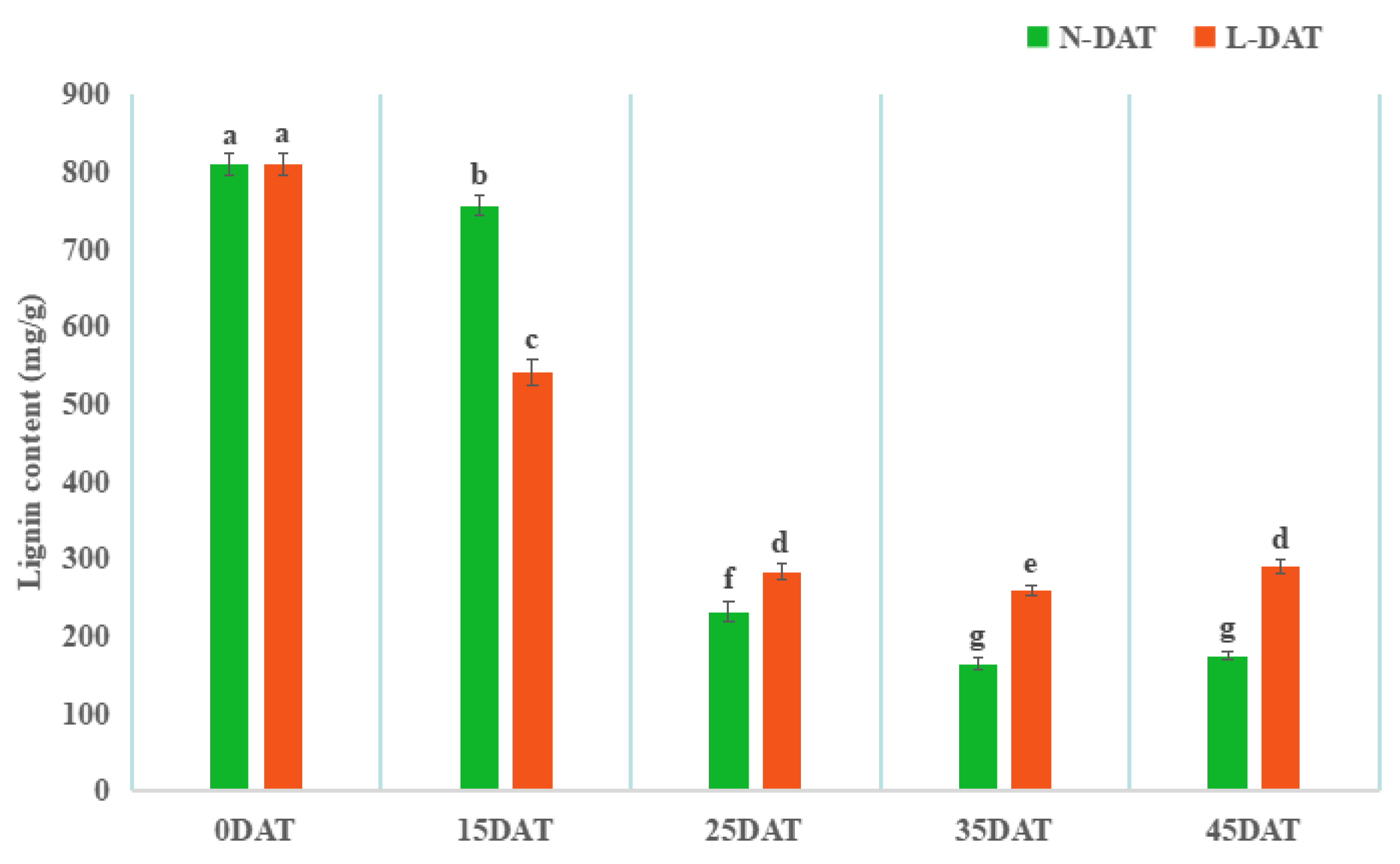
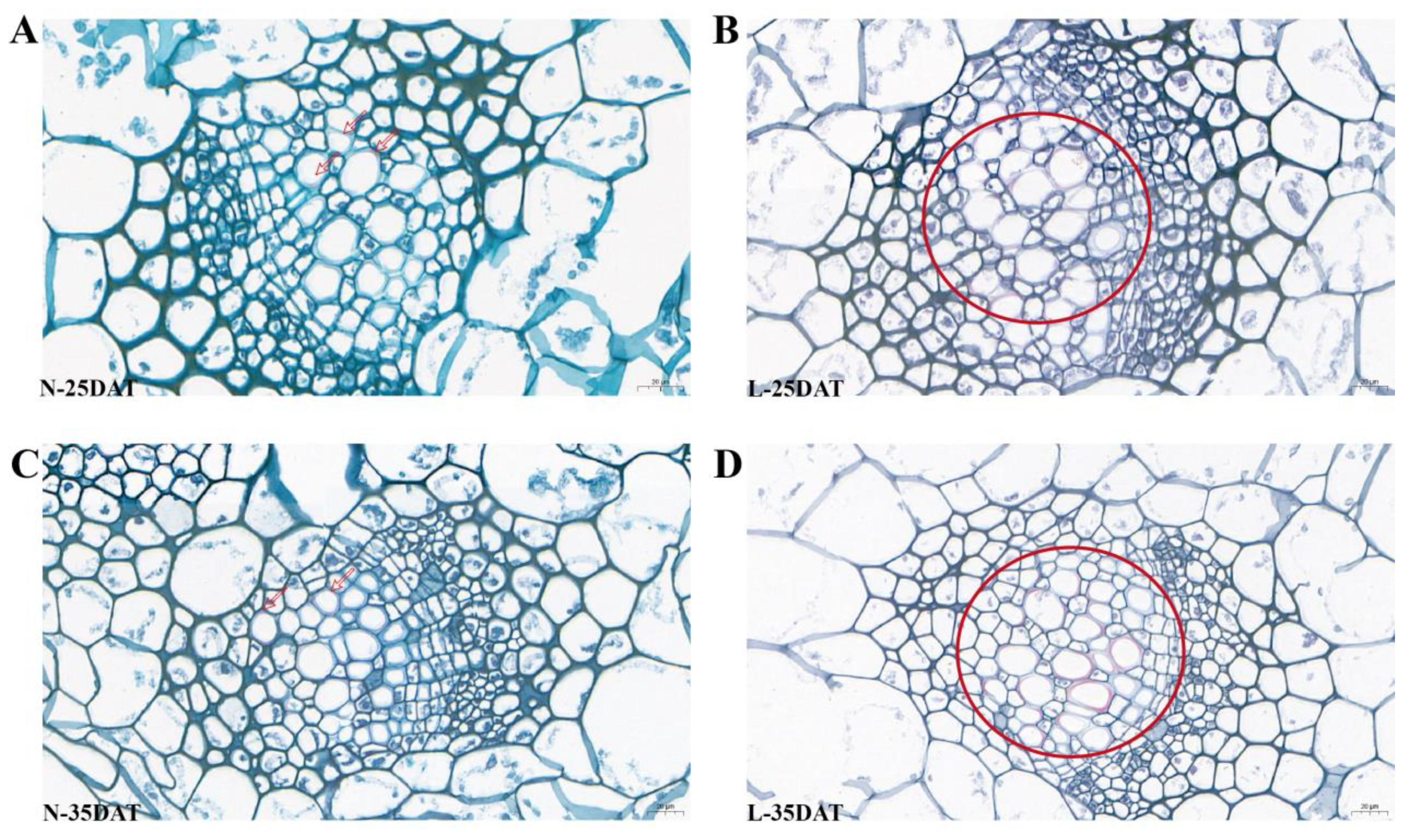
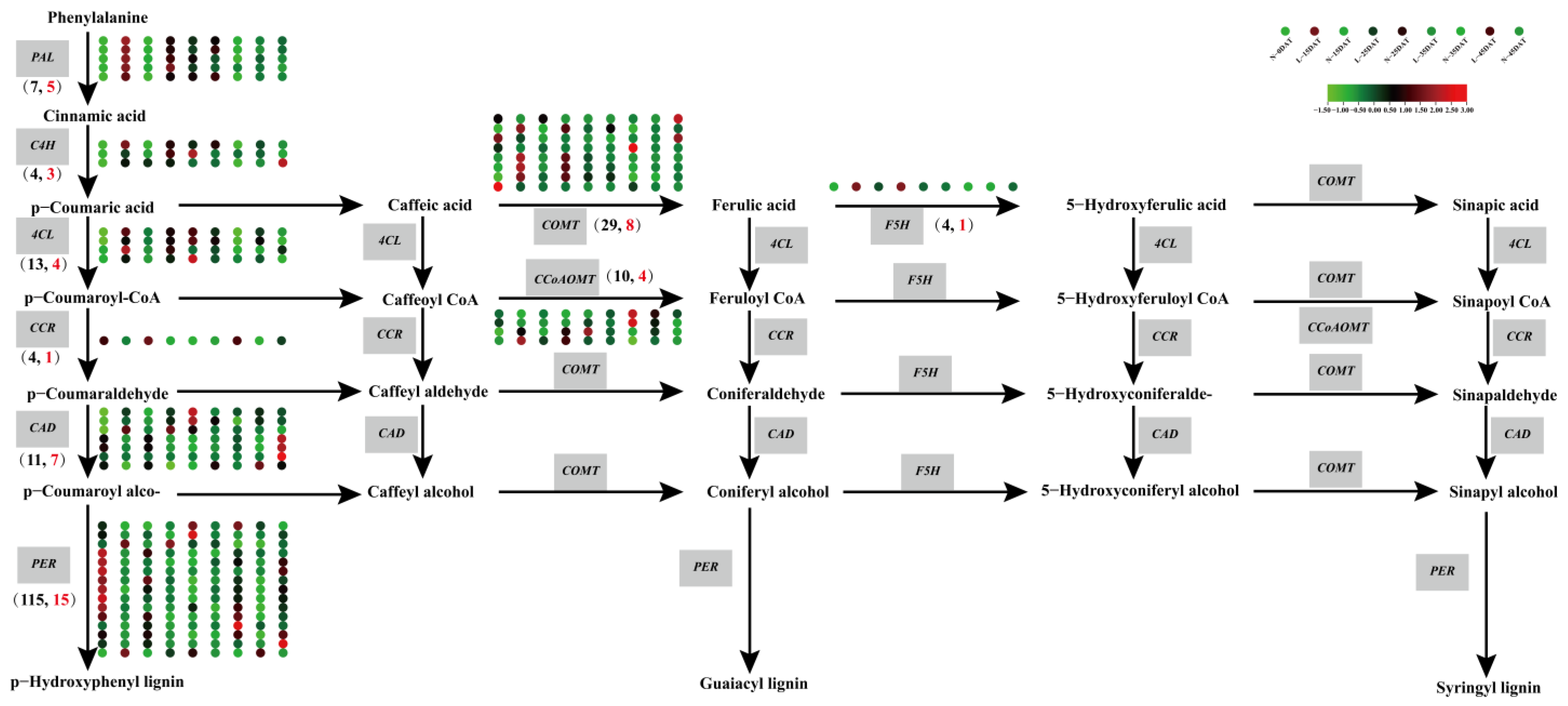
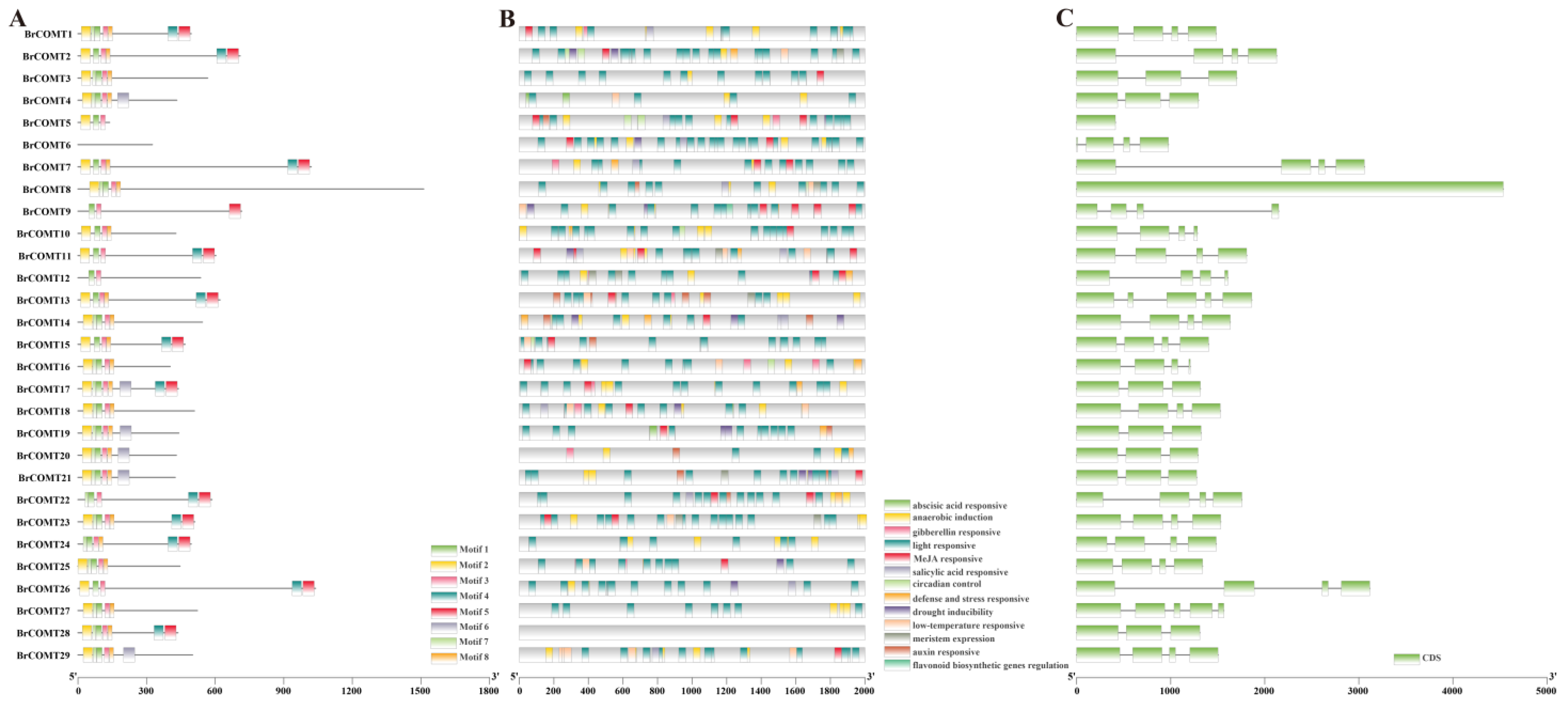
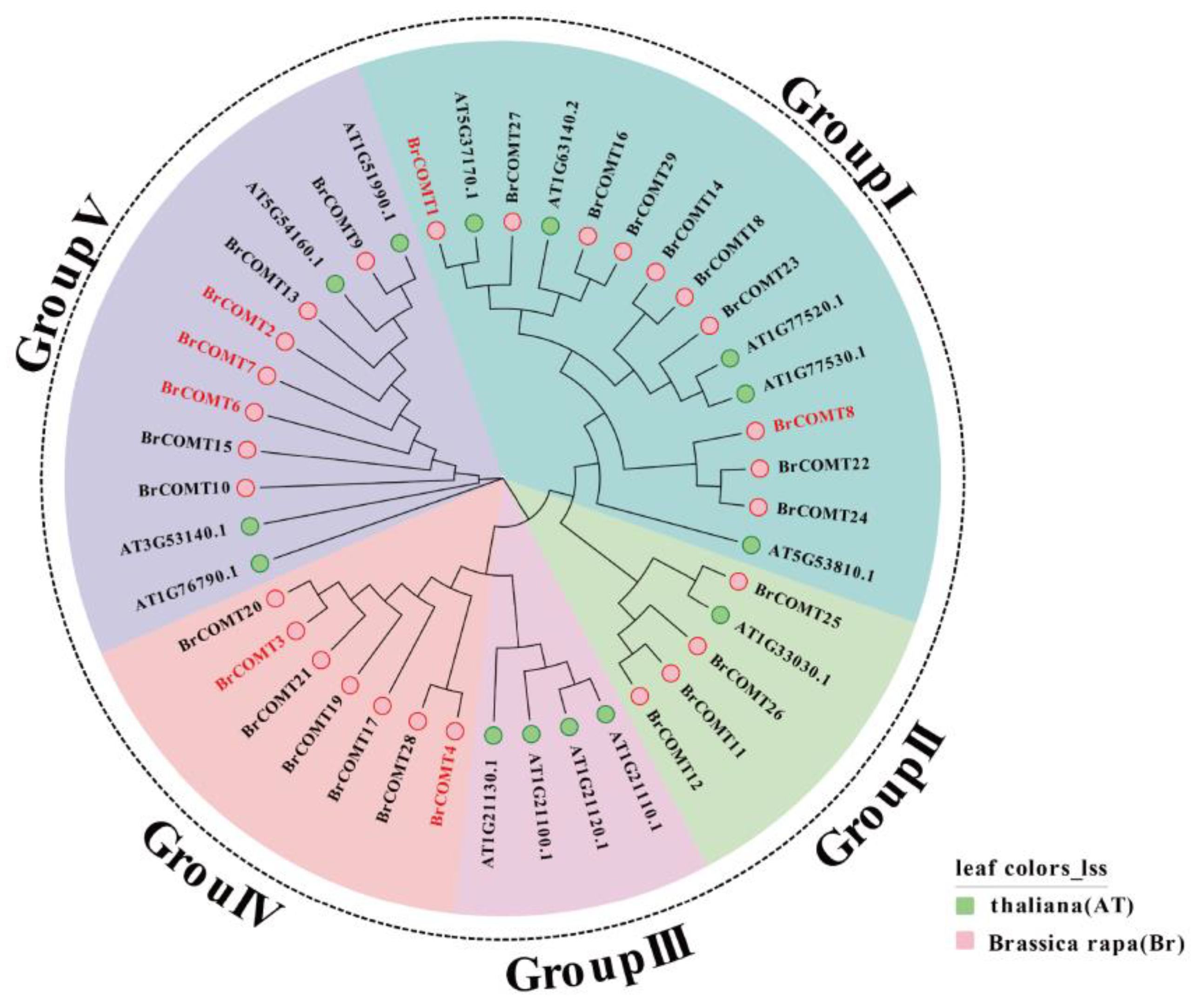
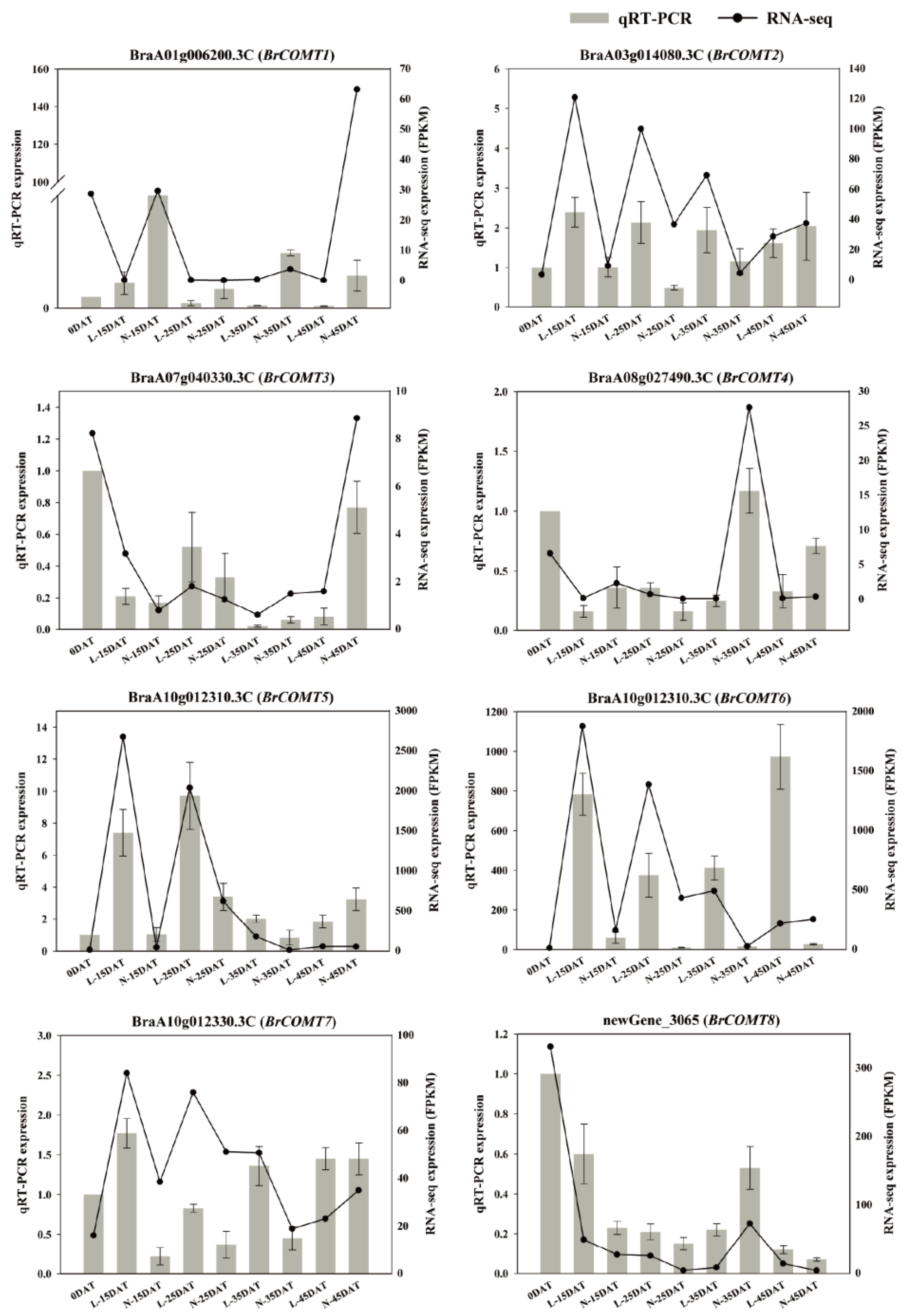
Publisher’s Note: MDPI stays neutral with regard to jurisdictional claims in published maps and institutional affiliations. |
© 2022 by the authors. Licensee MDPI, Basel, Switzerland. This article is an open access article distributed under the terms and conditions of the Creative Commons Attribution (CC BY) license (https://creativecommons.org/licenses/by/4.0/).
Share and Cite
Dai, Y.; Wang, S.; Huang, W.; Li, Z.; Zhang, S.; Zhang, H.; Li, G.; Fang, Z.; Sun, R.; Li, F.; et al. Transcriptome Analysis of Chinese Cabbage Provides Insights into the Basis of Understanding the Lignin Affected by Low Temperature. Genes 2022, 13, 2084. https://doi.org/10.3390/genes13112084
Dai Y, Wang S, Huang W, Li Z, Zhang S, Zhang H, Li G, Fang Z, Sun R, Li F, et al. Transcriptome Analysis of Chinese Cabbage Provides Insights into the Basis of Understanding the Lignin Affected by Low Temperature. Genes. 2022; 13(11):2084. https://doi.org/10.3390/genes13112084
Chicago/Turabian StyleDai, Yun, Shaoxing Wang, Wenyue Huang, Ze Li, Shifan Zhang, Hui Zhang, Guoliang Li, Zhiyuan Fang, Rifei Sun, Fei Li, and et al. 2022. "Transcriptome Analysis of Chinese Cabbage Provides Insights into the Basis of Understanding the Lignin Affected by Low Temperature" Genes 13, no. 11: 2084. https://doi.org/10.3390/genes13112084
APA StyleDai, Y., Wang, S., Huang, W., Li, Z., Zhang, S., Zhang, H., Li, G., Fang, Z., Sun, R., Li, F., & Zhang, S. (2022). Transcriptome Analysis of Chinese Cabbage Provides Insights into the Basis of Understanding the Lignin Affected by Low Temperature. Genes, 13(11), 2084. https://doi.org/10.3390/genes13112084





